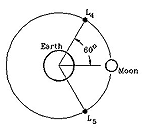|
However, there is a loophole. If the spacecraft is placed between Sun and Earth, the Earth's gravity pulls it in the opposite direction and cancels some of the pull of the Sun. With a weaker pull towards the Sun, the spacecraft then needs less speed to maintain its orbit.

If the distance is just right--about 4 times the distance to the Moon or 1/100 the distance to the Sun--the spacecraft, too, will need just one year to go around the Sun, and will keep its position between the Sun and the Earth. That position is the Lagrangian Point L1, so called after the Italian-French mathematician who pointed it out, Joseph Louis Lagrange (1736-1813).
The sister-site From Stargazers to Starships discusses Lagrangian points in more detail than is done here, among other things deriving
the distance of L1 (the derivation of L2 is almost identical) and also the equilibrium points
L4 and L5. While neither calculation requires calculus, both are somewhat lengthy and assume familiarity with basic principles of Newtonian mechanics, covered in preceding sections of the "Stargazers" site.
Spacecraft Observatories at L1
The L1 point is a very good position for monitoring the solar wind, which reaches it about one hour before reaching Earth. In 1978 the "International Sun-Earth Explorer-3" (ISEE-3) was launched towards L1, where it conducted such observations for several years. Equipped with an on-board rocket and an ample supply of fuel, ISEE-3 was later moved to the Earth's distant tail and still later was sent to intercept Comet Giacobini-Zinner. In November 1994 a new spacecraft, "WIND" was launched towards that position. It was originally scheduled to be stationed by 1996 in an orbit about the L1 point, but later it was sent on a more extended mission in a "flower petal" orbit around Earth. More recently the solar wind at L1 has been monitored by the solar observatory "SOHO" and by "ACE"
whose main task is the study of energetic particles accelerated near the Sun.
Such a spacecraft must have its own rocket engine. First, the position is unstable: if the spacecraft slips off it, it will slowly drift away, and sooner or later some correcting action is needed. In fact, the preferred position is actually some distance to the side of L1, for if the spacecraft is right on the Sun-Earth line, the antennas which track it from Earth are also aimed at the Sun, a source of interfering radio waves. Thus corrections are in fact needed quite regularly. Furthermore, the most economic way of getting to L1 is letting the spacecraft pass close to the Moon and using the moon's gravity to extract an extra boost from the Moon's orbital motion. Those maneuvers too require on-board propulsion, as does the final approach to L1.
Other Lagrangian Points
There exists another Lagrangian point L2 at about the same distance from Earth but on the night side, away from the Sun. A spacecraft placed there is more distant from the Sun and therefore should orbit it more slowly than the Earth; but the extra pull of the Earth adds up to the Sun's pull, and this allows the spacecraft to move faster and keep up with the Earth. The L2 point has been chosen by NASA as the future site of a large infra-red observatory, the "Next Generation Space Telescope", renamed in honor of a late NASA director The James Webb Observatory.

There exist altogether 5 Lagrangian points in the Sun-Earth system and such points also exist in the Earth-Moon system. Among these, the most attention has been given to the two stable points L4 and L5, located in the Moon's orbit but off the position of the Moon (see picture). These positions have been studied as possible sites for artificial space colonies in some (very!) distant future.
For those interested in space colonies at the Lagrangian points:
- Gerald K. O'Neill, "The Colonization of Space", Physics Today September 1974, p. 32.
- Gerard K. O'Neill, "The High Frontier", William Morrow and Co., NY, 1977; Anchor Books (Doubleday) 1982.
|

